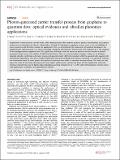Files in this item
Photon-generated carrier transfer process from graphene to quantum dots : optical evidences and ultrafast photonics applications
Item metadata
| dc.contributor.author | Wang, X. | |
| dc.contributor.author | Li, X. H. | |
| dc.contributor.author | Jiang, C. | |
| dc.contributor.author | Brown, C. Tom A. | |
| dc.contributor.author | Ning, J. Q. | |
| dc.contributor.author | Zhang, K. | |
| dc.contributor.author | Yu, Q. | |
| dc.contributor.author | Ge, X. T. | |
| dc.contributor.author | Wang, Q. J. | |
| dc.contributor.author | Zhang, Z. Y. | |
| dc.date.accessioned | 2020-08-03T15:30:11Z | |
| dc.date.available | 2020-08-03T15:30:11Z | |
| dc.date.issued | 2020-07-31 | |
| dc.identifier | 269160148 | |
| dc.identifier | 72f69c37-f717-45d1-a6bd-1f0a84ad462b | |
| dc.identifier | 000559817700002 | |
| dc.identifier | 85088776044 | |
| dc.identifier.citation | Wang , X , Li , X H , Jiang , C , Brown , C T A , Ning , J Q , Zhang , K , Yu , Q , Ge , X T , Wang , Q J & Zhang , Z Y 2020 , ' Photon-generated carrier transfer process from graphene to quantum dots : optical evidences and ultrafast photonics applications ' , npj 2D Materials and Applications , vol. 4 , 27 . https://doi.org/10.1038/s41699-020-00160-6 | en |
| dc.identifier.issn | 2397-7132 | |
| dc.identifier.other | ORCID: /0000-0002-4405-6677/work/86537103 | |
| dc.identifier.uri | https://hdl.handle.net/10023/20400 | |
| dc.description | The authors acknowledge Natural Science Foundation of China (Grant Nos. 61875222, 61875223, 61605106, 11874390). | en |
| dc.description.abstract | Graphene/III–V semiconductor van der Waals (vdW) heterostructures offer potential access to physics, functionalities, and superior performance of optoelectronic devices. Nevertheless, the lack of a bandgap in graphene severely restricts the controllability of carrier properties and therefore impedes its applications. Here, we demonstrate the engineering of graphene bandgap in the graphene/GaAs heterostructure via C and Ga exchange induced by the method of femtosecond laser irradiation (FLI). The coupling of the bandgap-opened graphene with GaAs significantly enhances both the harvest of photons and the transfer of photon-generated carriers across the interface of vdW heterostructures. Thus, as a demonstration example, it allows us to develop a saturable absorber combining a delicately engineered graphene/GaAs vdW heterostructure with InAs quantum dots capped with short-period superlattices. This device exhibits significantly improved nonlinear characteristics including <1/3 saturation intensity and modulation depth 20 times greater than previously reported semiconductor saturable absorber mirrors. This work not only opens the route for the future development of even higher performance mode-locked lasers, but the significantly enhanced nonlinear characteristics due to doping-induced bandgap opening of graphene by FLI in the vdW heterostructures will also inspire wide applications in photonic and optoelectronic devices. | |
| dc.format.extent | 8 | |
| dc.format.extent | 5402447 | |
| dc.language.iso | eng | |
| dc.relation.ispartof | npj 2D Materials and Applications | en |
| dc.subject | QC Physics | en |
| dc.subject | NDAS | en |
| dc.subject | BDC | en |
| dc.subject | R2C | en |
| dc.subject.lcc | QC | en |
| dc.title | Photon-generated carrier transfer process from graphene to quantum dots : optical evidences and ultrafast photonics applications | en |
| dc.type | Journal article | en |
| dc.contributor.institution | University of St Andrews. Centre for Biophotonics | en |
| dc.contributor.institution | University of St Andrews. Office of the Principal | en |
| dc.contributor.institution | University of St Andrews. School of Physics and Astronomy | en |
| dc.identifier.doi | 10.1038/s41699-020-00160-6 | |
| dc.description.status | Peer reviewed | en |
This item appears in the following Collection(s)
Items in the St Andrews Research Repository are protected by copyright, with all rights reserved, unless otherwise indicated.

